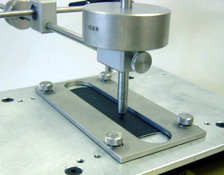Taber Reciprocating Abraser (Abrader)
The Taber® Reciprocating Abraser (Model 5900) can perform similar tests as the Taber Linear Abraser, but the notable difference is a sliding specimen platform moves in a horizontal, reciprocating motion under a stationary tool holder.  Other features include a counterbalanced arm which pivots on an adjustable height gantry system. The counterweight allows the user to balance the test arm, ensuring precise test load set-up without worrying about the weight of the test attachment. Incorporated at the end of the arm is a tool holder to which optional attachments and weights may be secured. Test parameters such as stroke length (6 - 155mm), speed (3 - 75 cycles per minute) and load (1N - 24N maximum, with included weights of , 2, 2.5, 5, 10 & 24N) are adjustable so optimal settings for each material can be established.
Other features include a counterbalanced arm which pivots on an adjustable height gantry system. The counterweight allows the user to balance the test arm, ensuring precise test load set-up without worrying about the weight of the test attachment. Incorporated at the end of the arm is a tool holder to which optional attachments and weights may be secured. Test parameters such as stroke length (6 - 155mm), speed (3 - 75 cycles per minute) and load (1N - 24N maximum, with included weights of , 2, 2.5, 5, 10 & 24N) are adjustable so optimal settings for each material can be established.
The Wearaser® collet assembly comes standard with each Taber Reciprocating Abraser, along with CS-10 and H-18 Wearaser abradants. This permits abrasion testing of most flat objects in a linear fashion. The size and shape of a pencil eraser, the Wearaser uses the same high quality Taber abrasive media found in our world-famous wheels.
Designed to satisfy the apparatus described in GM test methods, optional interchangeable attachments (sold separately) provide testing versatility. This allows the Reciprocating Abraser to be configured to perform tests such as wear, scratch, mar, scrape, rub, plus others. Most attachments that work with the Taber Linear Abraser will also work with the Reciprocating Abraser - Jumbo Wearaser; Multi-Mar Attachment; Crockmeter; Scratch Tips; ScotchBrite Kit; Universal Attachment; etc. And for those interested in maximizing your testing, the system is expandable and can accommodate two additional test arm kits, permitting up to three tests to be performed simultaneously.
The standard specimen table provided with the Reciprocating Abraser is 216mm x 278mm (8.5” x 11”) with drilled tapped holes to accommodate specimen clamps or optional specimen fixing plates. To evaluate most flat specimens, specimen clamps or the optional Wide Slot Fixing Plate may be suitable. For flexible materials such as textile products, the optional Specimen Fixing Plate Kit might be used.
 |
 |
 |
DATA SHEET:


